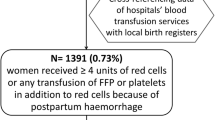Summary
To date there are no data in the literature on the procedure for the indirect measurement of blood loss during cesarean section, based on the post-operative drop in haemoglobin (Hb), which has been due to the lack of biometrically determined parameters for the calculation of blood volume in pregnant women. This study was therefore conducted to determine the applicability of the drop in Hb levels blood loss calculation during cesarean section, based on a model previously validated in non-pregnant women. We compared this procedure in 54 patients who underwent cesarean section and 12 non-pregnant patients subjected to gynaecological surgery. The coefficient of the regression slope for the blood volume collected during surgery and the calculated blood loss in pregnant (y=0.6286x+366) and non-pregnant patients (y=0.7605x+514) did not show any significant difference (t=1.1009, p>0.5, 95% confidence interval:−2.736, +2.473). Our study therefore demonstrated the applicability of the procedure for the indirect measurement of surgical blood loss both in pregnant and non-pregnant women.
Similar content being viewed by others
References
Markantonis S.L., Kostopanagiotou G., Panidis D., Smirniotis V., Voros D. (2004) Effects of blood loss and fluid volume replacement on serum and tissue gentamycin concentrations during colorectal surgery. Clin. Ther., 26, 271–281.
Flordal P.A., Neander G. (1991) Blood loss in total hip replacement. Arch. Orthop. Trauma. Surg., Ill, 34–38.
Flordal P.A. (1997) Measurement of blood loss in clinical studies. Eur. J. Anaesthesiol., 14 (Suppl 14), 35–37.
Allen T.H., Peng M.X., Chen K.P., Huang T.F., Chang C., Fang H.S. (1956) Prediction of blood volume and adiposity in man from body weight and cube of height. Metabolism, 5, 328–345.
Nadler S.B., Hidalgo J.U., Bloch T. (1962) Prediction of blood volume in normal human adults. Surgery, 51, 224–232.
Lagneau F., Marty J., Beyne P., Tod M. (2005) Physiological modeling for indirectevaluation of drugtissular pharmacokinetics under non-steady-state conditions: an example of antimicrobial prophylaxis during liver surgery. J. Pharmacokin. Pharmacodyn. 32, 1–32.
Bauer L.A., Horn J.R., Maxon M.S., Easterling T.R., Shon D.D., Strandness D.E. (2000) Effect of metoprolol and verapamil administered separately and concurrently after single doses on liver blood flow and drug disposition. J. Clin. Pharmacol., 40, 533–543.
Author information
Authors and Affiliations
Rights and permissions
About this article
Cite this article
Popović, J., Grujić, Z. Influence of pregnancy on one-compartmental bio-metric blood loss calculations after cesarean section and gynaecological surgery. Eur. J. Drug Metabol. Pharmacokinet. 33, 53–59 (2008). https://doi.org/10.1007/BF03191019
Received:
Issue Date:
DOI: https://doi.org/10.1007/BF03191019




